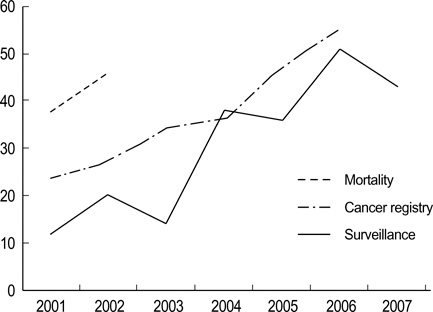J Korean Med Sci.
2009 Jun;24(3):363-367. 10.3346/jkms.2009.24.3.363.
Overview of Asbestos Issues in Korea
- Affiliations
-
- 1Department of Preventive Medicine and Industrial Medical Center, the Catholic University of Korea, College of Medicine, Seoul, Korea. cyclor@catholic.ac.kr
- KMID: 1779149
- DOI: http://doi.org/10.3346/jkms.2009.24.3.363
Abstract
- Asbestos is a carcinogen that causes diseases such as mesothelioma and lung cancer in humans. There was a sharp increase in the use of asbestos in Korea in the 1970s as Korea's economy developed rapidly, and asbestos was only recently banned from use. Despite the ban of its use, previously applied asbestos still causes many problems. A series of asbestos-related events that recently occurred in Korea have caused the general public to become concerned about asbestos. Therefore, it is necessary to take proper action to deal with asbestos-related events, such as mass outbreaks of mesothelioma among residents who lived near asbestos textile factories or asbestos mines. Although there have been no rapid increases in asbestos-related illnesses in Korea to date, such illnesses are expected to increase greatly due to the amount of asbestos used and long latency period. Decreasing the asbestos exposure level to levels as low as possible is the most important step in preventing asbestos-related illnesses in the next few decades. However, there is a lack of specialized facilities for the analysis of asbestos and experts to diagnose and treat asbestos-related illnesses in Korea; therefore, national-level concern and support are required.
Keyword
MeSH Terms
Figure
Reference
-
1. Choi JK, Paek DM, Paik NW. The production, the use, the number of workers and exposure level of asbestos in Korea. Korean Ind Hyg Assoc J. 1998. 8:242–253.2. Park D, Choi S, Ryu K, Park J, Paik N. Trends in occupational asbestos exposure and asbestos consumption over recent decades in Korea. Int J Occup Environ Health. 2008. 14:18–24.
Article3. Paek DM, Paik NW, Choi JD, Son MA, Im JG, Lee WJ, Moon YH, Park JS, Choi BS. Prevalence of asbestosis in Korean asbestos industry. Korean J Occup Environ Med. 1995. 7:46–57.
Article4. Jung SH, Kim HR, Koh SB, Yong SJ, Choi BS, Ahn YS, Park TI, Chung MJ, Kim YM, Song JS, Chung YK, Myung JP. Epidemiologic characteristics revealed with a malignant mesothelioma surveillance system in Korea. Korean J Occup Environ Med. 2006. 18:46–52.
Article5. Kang DM, Gu DC, Kim KH. Asbestos-related diseases among asbestos textile factory workers and residents around the factory. J Korean Med Assoc. 2009. 52:482–488.
Article6. Ahn YS, Kim HR. Asbestosis epidemics caused by non-occupational neighborhood exposure. J Korean Med Assoc. 2009. 52:472–481.
Article7. Luo S, Liu X, Mu S, Tsai SP, Wen CP. Asbestos related diseases from environmental exposure to crocidolite in Da-yao, China. I. Review of exposure and epidemiological data. Occup Environ Med. 2003. 60:35–41.8. Metintas S, Metintas M, Ucgun I, Oner U. Malignant mesothelioma due to environmental exposure to asbestos: follow-up of a Turkish cohort living in a rural area. Chest. 2002. 122:2224–2229.9. Pan XL, Day HW, Wang W, Beckett LA, Schenker MB. Residential proximity to naturally occurring asbestos and mesothelioma risk in California. Am J Respir Crit Care Med. 2005. 172:1019–1025.
Article10. Constantopoulos SH, Malamou-Mutsi VD, Goudevenos JA, Papathanasiou MP, Pavlidis NA, Papadimitriou CS. High incidence of malignant pleural mesothelioma in neighbouring villages of Northwestern Greece. Respiration. 1987. 51:266–271.
Article11. Levin SM, Kann PE, Lax MB. Medical examination for asbestosrelated disease. Am J Ind Med. 2000. 37:6–22.
Article12. Hillerdal G, Henderson DW. Asbestos, asbestosis, pleural plaques and lung cancer. Scand J Work Environ Health. 1997. 23:93–103.
Article13. Henderson DW, Rödelsperger K, Woitowitz HJ, Leigh J. After Helsinki: a multidisciplinary review of the relationship between asbestos exposure and lung cancer, with emphasis on studies published during 1997-2004. Pathology. 2004. 36:517–550.
Article14. Rom WN. Rom WN, editor. Asbestosis, pleural fibrosis, and lung cancer. Environmental and Occupational Medicine. 2007. 4th ed. Philadelphia: Lippincott William & Wilkins;308.15. Suzuki Y. Diagnostic criteria for human diffuse malignant mesothelioma. Acta Pathol Jpn. 1992. 42:767–786.16. Robinson BW, Lake RA. Advances in malignant mesothelioma. N Engl J Med. 2005. 353:1591–1603.
Article17. McDonald JC, Armstrong BG, Edwards CW, Gibbs AR, Lloyd HM, Pooley FD, Ross DJ, Rudd RM. Case-referent survey of young adults with mesothelioma: I. Lung fibre analyses. Ann Occup Hyg. 2001. 45:513–518.
Article18. Gardner MJ, Saracci R. Effects on health of non-occupational exposure to airborne mineral fibres. IARC Sci Publ. 1989. 90:375–397.19. Kim HR, Ahn YS, Jung SH. Epidemiologic characteristics of malignant mesothelioma in Korea. J Korean Med Assoc. 2009. 52:449–455.
Article20. Kjaerheim K, Ulvestad B, Martinsen JI, Andersen A. Cancer of the gastrointestinal tract and exposure to asbestos in drinking water among lighthouse keepers (Norway). Cancer Causes Control. 2005. 16:593–598.
Article21. Browne ML, Varadarajulu D, Lewis-Michl EL, Fitzgerald EF. Cancer incidence and asbestos in drinking water, Town of Woodstock, New York, 1980-1998. Environ Res. 2005. 98:224–232.
Article22. Gamble JF, Gibbs GW. An evaluation of the risks of lung cancer and mesothelioma from exposure to amphibole cleavage fragments. Regul Toxicol Pharmacol. 2008. 52(1):Suppl. S154–S186.
Article
- Full Text Links
- Actions
-
Cited
- CITED
-
- Close
- Share
- Similar articles
-
- Types and Health Hazards of Fibrous Materials Used as Asbestos Substitutes
- Occupational and Environmental Asbestos Exposure in Korea
- Radiologic Diagnosis of Asbestos-Related Lung Cancer
- Analysis of Pulmonary Asbestos Body in Malignant Mesothelioma: A case report
- Compensation and Diagnosis of Asbestos Related Disease


